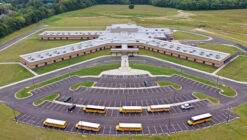The Gold Standard: Methodist Hospital Pavilion Wins LEED Recognition
From The Commercial Appeal
One thing was missing when the doors opened on the new Women and Children’s Pavilion at Methodist Le Bonheur Germantown Hospital — that new-building smell.
The smell that delights new home and car owners, but one clearly born from glue and paint fumes, just wasn’t there. And that was on purpose.
“We used low (volatile organic compound) paints, sealants, caulk and furniture so you don’t have those gases being emitted,” said Donna Hess, project and construction manager for Methodist Germantown. “When you walk into a new home, and you smell the paint and the new carpet, you’re smelling harmful gases. This building did not have a smell to it when it was finished.”
“We used low (volatile organic compound) paints, sealants, caulk and furniture so you don’t have those gases being emitted,” said Donna Hess, project and construction manager for Methodist Germantown. “When you walk into a new home, and you smell the paint and the new carpet, you’re smelling harmful gases. This building did not have a smell to it when it was finished.”
To get LEED designations, builders must prove their projects’ carbon footprints are small and their energy savings are large.
But getting certified is neither easy nor cheap. Methodist paid $510,000 for the services required to get the certification alone. That’s on top of the nearly $124 million construction project, the most expensive project in Germantown’s history.
The Women and Children’s pavilion is the first LEED gold-certified hospital in the Southeast and one of only seven gold-certified hospitals in the nation, according to the U.S. Green Building Council, the organization that developed LEED standards. There are 184 LEED-certified health care projects in the U.S., according to the council, of which 23 are hospitals.
“Certifying a hospital can be a bit tougher,” said Marie Coleman, a spokeswoman for the USGBC. “As with any facility that runs 24 hours a day, and especially with hospitals which have such high energy needs, it can be difficult, but certainly not impossible as seen by the amount of certified hospitals we already have.”
Seminary chapel on its grounds. They crushed the chapel’s bricks and salvaged its steel and ended up using 90 percent of the old building in the new pavilion building.
From there, hospital officials opted to use environmentally vetted construction materials, nearly half from a maximum of a 500-mile radius from the construction site.
They selected low-volume, motion-activated faucets and motion-activated, lowemission lights. They painted the tops of the building and the adjacent parking garage white to reflect sunlight, which helps keeps them naturally cool.
They designated 32 parking spots for low-emission, fuel-efficient cars. They installed bike racks and gave their employees changing rooms for cleaning up after a bike ride to work.
The pavilion’s new power plant is 20 percent more efficient than traditional models. The reinforced grass strips surrounding the parking garage replaced traditional asphalt or concrete to allow for greater rainwater absorption rather than run-off.
“The goal for Methodist was to produce an environmentally sustainable building without over-spending the budget,” said Rick Boeving, a principal at Memphis-based engineering firm Allen & Hoshall, who led Methodist through the LEED certification process.
Boeving, a LEED Accredited Professional, said he watched the design and construction industries trend toward sustainability over the years. More construction products have more recycled contents, he said, and more products are costing less.
But William Kenley, CEO of Methodist Germantown, said the LEED plan for the Women and Children’s Pavilion was decided by system leaders in 2005.
“There was some frustration at the time that we were limited by the (environmental) things we could do with the buildings we were in,” Kenley said. “Sometimes, unless it was a new building, you just couldn’t get there from here. We wanted to look at constructing new buildings in a way that would be consistent with out overall sustainability goals.”
— Toby Sells: 529-2742 Interested in all things green?: Check out The Commercial Appeal’s weekly digital magazine focused on the environment.










